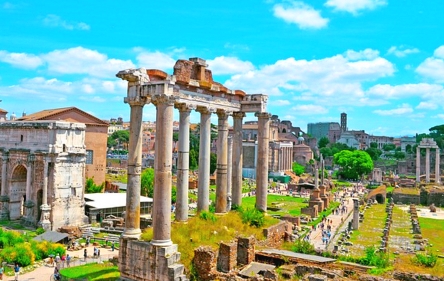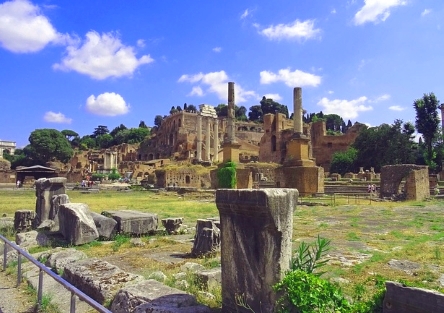Today the Roman Forum (also in English the Latin name Forum Romanum is used) is by far the most important and largest excavation site in Rome. The Palatine also belongs to the fenced area near the Colosseum. It is one of the seven hills of ancient Rome. Here the city of Rome is said to have been founded according to legend. The Roman Forum was probably the oldest inhabited area in ancient Rome.
If you want to have a look at the whole area, you should have a fit day. Kilometre-long paths lead through the excavation site. There is a lot to see, including a museum, gardens and much more. You get lost especially on the Palatine fast, we searched for half an hour of the way from the Palatine back to the Roman Forum despite Google Maps on the smartphone.
 Pillars and remains of houses
Pillars and remains of houses
It is a good idea to read a good guidebook about the excavations beforehand and to have an appropriate book with you. The more you know about the things you see, the more interesting it is.
In principle, the Forum Romanum was the central square in ancient Rome and the centre of the city. Right next to the Forum (town square) were many important buildings of the ancient city of Rome. The hill Palatine was a few hundred meters away. At that time, as today, you have to cover a height of approximately 50 metres in order to get from the Roman Forum to the Palatine.
Romulus is said to have founded the city of Rome on the Palatine after winning a competition against his Revalen Remus. According to many ancient traditions this was in the year 753 B.C., some old data are even more exact. They speak of April 21 in 753 BC. How much of the history was and how much legend is still unclear today.

From the Palatin, you also have a good view to the Circus Maximus. In ancient Rome this was a racecourse for car races. Unfortunately not much of the Circus Maximus is preserved.
Worth seeing is the museum on the Palatin. There is also a toilet. The entrance to the museum is free or included in the entrance fee of the whole excavations. We liked the Farnesian gardens, for instance between the Roman Forum and the Palatine. The Farnesian Gardens could have been the first botanical garden in the world.
Plan Roman Forum
It’s a larger area near the Colosseum
There is another, similarly large excavation in Rome, namely the excavation of Ostia, about 25 km outside the centre by the sea. This was the great port of Rome in ancient times. Today Ostia is the largest seaside resort near Rome.
Information for tourists
The entrance most used by tourists is only about 300 meters away from the Colosseum. In front of the Colosseum is a subway station called Colosseo (Metro Line B). The area of the excavation between Palatine and Roman Forum is very large, also in other places there are entrances and exits. You can also take the tram line 30 to Roman Forum.
Admission Roman Forum and Palatine 2024
There is only one combination ticket for the Colosseum, Palatine Hill and Roman Forum. It costs about 20 Euro, children under 18 do not have to pay admission. For EU citizens under 26, there is a reduced entrance fee of around 10 Euro for all three sights. The ticket is valid for 2 days, i.e. you can visit the Colosseum on one day and the Palatine and Roman Forum on the other.
Our tip: Tickets for the Colosseum and Roman ForumThe tickets are not necessarily cheap, but they are not overpriced for such a world-famous ancient building. Very many visitors buy Colosseum tickets in advance on the internet, especially to avoid queuing for hours at a ticket office at the entrance. The queues are often hundreds of metres long. The tickets are available on the well-known and good German-language website Getyourguide.de: |
Opening hours Roman Forum and Palatine 2024
The excavation is visited daily by more than 10,000 people. It is open every day of the week. The Roman Forum is only closed on a few public holidays. The opening times are from 8:30 daily. The excavation site closes sooner or later, depending when it gets dark. In the summer until the end of August is open until 19:15, in some months in winter only until 16:30.
Names in foreign languages
In Italian the ancient square is the “Foro Romano”, in the international tourist language English it is called “Roman Forum”. The old Latin name is “Forum Romanum”.
The hill Palatine is in Italian the Palatino, in English the Palatine Hill. The ancient Romans called the small mountain “Mons Palatinus”.
History Roman Forum
The Roman Forum, also known as the Roman Forum, was once the political, social and economic centre of ancient Rome. It housed many important public buildings, including temples, government offices and courts, and was the scene of some of the most important events in ancient Roman history. Today, the Roman Forum is one of the most important archaeological sites in the world and a popular destination for visitors to Rome.
The history of the Roman Forum dates back to the 7th century BC. Century BC, when this area was used as a market. Over the centuries it developed into the centre of ancient Rome, and in the first century it was the centre of the Roman Empire. During this period, the Roman Forum was home to many of the city’s most important buildings, including the Temple of Saturn, the Temple of Vesta and the Julian Basilica.
One of the most impressive buildings on the Roman Forum was the Senate Building, the seat of political power in ancient Rome. This is where the Senate met and made important decisions, and it was also the seat of the city’s highest elected official, the consul. The Senate is also the scene of many famous speeches and debates, such as those of Julius Caesar and Mark He Antony.
Another important building on the Roman Forum was the Basilica Emilia, which served as a court and was used for commercial purposes. The building was constructed in the 2nd century BC. It was built in the 2nd century BC and is one of the largest and most impressive buildings in the city. It was also the site of its Hostilia, the famous Curia, where the Roman Senate met.
Despite its central role in ancient Roman history, the Roman Forum became less important over the centuries and much of the site was abandoned in the 5th century. Over time, layers of dirt and rubble covered the Forum and destroyed many of its buildings and monuments. In the 19th century, however, excavations began in the area and many of the ancient buildings and monuments were rediscovered. Today, the Roman Forum is one of Rome’s most popular tourist attractions, where visitors can admire the rich history and impressive ancient ruins. The site is home to many important buildings and monuments, such as the Arch of Titus, the Temple of Julius Caesar and the Column of Phocas. The Roman Forum is also an important site for anyone interested in Roman history and is considered one of the most important archaeological sites in the world.
Our tip: Tickets for the Colosseum and Roman ForumThe tickets are not necessarily cheap, but they are not overpriced for such a world-famous ancient building. Very many visitors buy Colosseum tickets in advance on the internet, especially to avoid queuing for hours at a ticket office at the entrance. The queues are often hundreds of metres long. The tickets are available on the well-known and good German-language website Getyourguide.de: |
In short, the Roman Forum is a must-see for anyone interested in ancient history and archaeology. Its rich history, impressive ruins and central role in Roman history make it a truly unique and unforgettable experience. Whether you want to visit the ruins of the Senate House, explore ancient temples or stroll through this wonderful place, the Roman Forum is a truly magnificent and enchanting destination not to be missed.